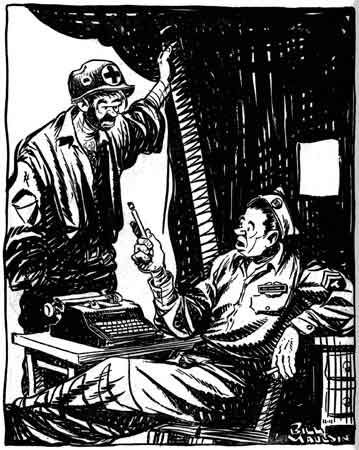

CaptO:-
Thanks for a great account of a great soldier and human being.
What "frosted" the BTDTs was this type of situation where a
clerk is telling the Medic he is NOT a Combat Soldier but only
a Medic. Most BTDTs loved the Medics unashamedly!!!!
Oh by the way notice the Clerk is wearing his CIB

Sgtleo
Too far forward not to wear a tie and back far enough not to have to salute.
I saw the CIB . Roque BTDT seen it


Rocky:-
We had a little different saying - "Too far forward to wear a
tie and way too far back to get shot"!!
CaptO:-
Reading what you said above about the Navy Corpsmen. I
had a boyhood friend who was a Corpsman 1st/c and I could
never get over his Marine Uniform with the Navy Crow on his arm.
I have a good Marine story about a very Famous Marine who was
a member of Carlson's Raiders and stayed in after WWII and rose
to the rank of a Bird Col. in the Reserve.
Sgtleo 
There are several good sites on the net concerning WWII medics.
The WWI Combat Medic
From the same site:
Medical Detachment Attached To Infantry Regiment
MEDAL of HONOR Citations – MEDICAL PERSONNEL
The Combat Medical Badge
Brief History: the Medical Badge was finally introduced March 3, 1945 for medical personnel who served with the Medical Detachments during WW2 . Let’s have a brief history of this insignia . The introduction of both E.I.B. (Expert Infantryman Badge) and C.I.B. (Combat Infantryman Badge) in November 1943 created an administrative problem and caused wide concern about medical personnel and Infantrymen . Although medical personnel, regularly attached to an Infantry unit were running considerable hazards when carrying out their duty, they were NOT entitled to the C.I.B. ! (though some Commanders did obtain CIBs for the combat medics) Army Regulations strictly forbade granting combat awards, since this was against the Geneva Convention and the non-combatant (i.e. neutral) status of medical personnel ! In fall of 1944, the War Department once more stressed that it was forbidden to grant EIBs and CIBs to medical personnel and Chaplains ! This was because a lot of Infantrymen (acknowledging the risk and courage of combat medics, attached to Infantry units) complained it was unfair to treat aidmen this way, and also some people were thoroughly frustrated they could not earn the extra $ 10.00/month of combat pay (which went with the CIB award) . Hence the introduction by the Surgeon General’s Office of a special badge to honor medical personnel ! The design was adopted 3 March 1945, and the official uniform regulations appeared on April 18, 1945 (C-3 of AR 600-35) .
Description: The Medical Badge (AG 421/3 Mar 45) "A STRETCHER PLACED HORIZONTALLY BEHIND A CADUCEUS WITH THE CROSS OF THE GENEVA CONVENTION AT THE JUNCTION OF THE WINGS, ALL ENCLOSED BY AN ELLIPTICAL OAK WREATH 1-IN IN HEIGHT AND 1 ½ -IN IN WIDTH, OF OXIDIZED SILVER" . statement: The War Department has authorized wear of a Medic’s Badge for personnel who served with the Medical Detachments of Infantry Regiments or smaller units, since the beginning of the War . The subsequent Bill of Congress will give those people an extra $ 10.00-a-month pay as provided for combat infantrymen . Medics up to and including rank of Captain are eligible, as well as Regimental Surgeons The Medical Badge shall be worn above decorations and/or ribbons, over the left breast pocket of the uniform coat or jacket . SOURCE:AR 600-35 C 3, Army Regulations, Changes No. 3, War Department, Washington 25, D.C., 18 April 1945 (Listing of Changes to AR 600-5, 31 March 1944, together with other modifications governing the use of prescribed service uniforms)
![]()
![]()
